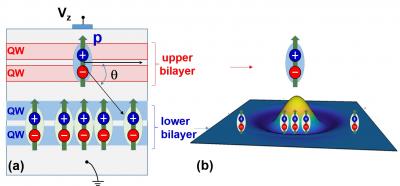

Interaction between excitonic dipoles: (a) excitons in stacked bilayers consisting of GaAs quantum wells (QWs). (b) Excitons in the upper bilayer induce, via the attractive inter-bilayer excitonic interaction, exciton accumulation in the lower bilayer.
Credit: Paulo V. Santos, Mikhail Lemeshko, and Ronen Rapaport
Usage Restrictions: The image may only be used with appropriate caption and credit.
“Birds of a feather flock together”: this old proverb may apply to several life circumstances but it certainly does not apply to electric charges: charges of same polarity always repel each other, while only charges of opposite polarity attract. One consequence of the attraction between dissimilar charges is the formation of excitons (electron-hole-pairs) in semiconductors.
Such pairs of negatively charged electrons and positively charged holes can be created via the absorption of light quanta (photons). Excitons are so-called quasi-particles that results from the bonding of an electron and a hole by the attractive electrostatic coulomb interaction between them. Excitons are mobile but not stable since the electrons and holes can quickly recombine leading to the emission of a photon.
Long-living excitons can, however, be created in special semiconductor bilayers consisting of two closely spaced quantum wells separated by a thin potential barrier (see Figure). If a bias voltage is applied to the structure the electrons and holes that form the exciton will be stored in separate quantum wells: this charge separation significantly increases the recombination lifetime.
These long living excitons acquire a dipole moment p and are thus known as dipolar (or indirect) excitons.
The excitons as well as dipolar excitons are neutral particles to the outside and the question arises how dipolar excitons interact with each other. The answer can be found by considering them to be aligned dipoles.
Contrary to the electrostatic coulomb interaction between two charges, which only depends on the distance between them, the interaction between two dipoles depends both on the relative orientation between their dipoles and the vector connecting them. For aligned dipoles like the dipolar excitons in the figure, the interaction changes from repulsive to attractive as the angle between them increases from 0 to 90 degrees.
Experiments on dipolar excitons carried out so far used excitons in a single bilayer, where one can only probe the repulsive component of the dipolar interaction. Now an international team of researchers from Paul-Drude-Institut für Festkörperelektronik in Berlin, the Hebrew University of Jerusalem, the Institute of Science and Technology Austria and the University of Princeton found a clever way to overcome the challenges by stacking two dipolar layers, as illustrated in the figure: in this way, they were able to demonstrate for the first time the attractive dipole-dipole component of the coupling between the particles, with surprising results.
They show that the presence of dipolar excitons in one of the bilayers induces an accumulation of dipolar excitons in the second bilayer. The latter proves that under appropriate conditions the old proverb also applies to dipolar excitons.
Recently, dipolar quantum gases and liquids attracted a lot of attention, since they host a plethora of exotic many-particle phenomena originating in the long-range and anisotropic character of the dipole-dipole interactions. Dipolar phases of matter have so far been mostly studied in the context of ultracold gases of polar molecules and magnetic atoms: a good example is the recently observed supersolidity – crystals where the atoms flow without friction. Such low-density ensembles, however, make it challenging to achieve the regime of strong interparticle interactions, where most of the exotic physics takes place.
The strong attractive inter-bilayer attractive coupling as demonstrated now by Hubert et al. makes the investigation of these phenomena in a solid-state system of dipolar fluids possible. In particular, it can probe dipolar densities and interaction strengths currently unavailable in atomic realisations, which is expected to reveal new collective effects and phases.
One example is the larger than expected mutual drag and binding energies between dipolar particles detected in the exciton experiments. This surprising effect is attributed to the appearance of electro-acoustic waves or polarons in the two fluids, mediated by the remote dipole-dipole interactions. As the fluid density increases, the polaron energy changes significantly, possibly representing the phase boundary between gas and liquid states.
This striking phenomenon is a good motivation for future experiments attempting the realisation of the exotic many-body phases with anisotropic interactions of strongly correlated quantum systems.















